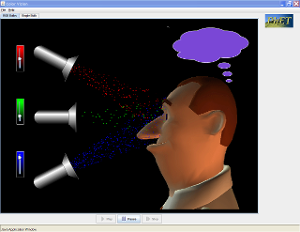Chapter 28 Color
|
Pace: 6 class periods
Checkpoint: 23 March |
|
ESSENTIAL QUESTION
|
STANDARDS COVERED
|
|
Kahoot and Differentiation
Pre and Post test data will be collected and used by the teacher to offer alternative projects to demonstrate mastery. You may also self select for an alternative assignment upon conferencing with your teacher. Please talk to your teacher if you have any questions. Student Examples: Paper Slides |
Ch 28 Textbook and Notes
| ||||||||||||||
28.1: The Color Spectrum
|
Standard Practiced:
P4.9B Big Idea: 1. By passing a narrow beam of sunlight through a triangular-shapped glass prism, Newton showed that sunlight is composed of a mixture of all the colors of the rainbow. Terms to know: Spectrum White Light |
28.2: Color by Reflection
| |||||||
| color.practice.doc | |
| File Size: | 49 kb |
| File Type: | doc |
MASTERY CHECK (10 min)
- (28.2) What happens to light of a certain frequency when it encounters atoms of the same resonant frequency?
- (28.3) What is the function of pigment?
Standard Practiced:
P4.9B
Big Idea:
1. The color of an opaque object is the color of the light it reflects.
2. The color of a transparent object is the color of the light it transmits.
Terms to Know:
Opaque
Frequency
Amplitude
Oscillations
Absorption
Transparent
Pigment
P4.9B
Big Idea:
1. The color of an opaque object is the color of the light it reflects.
2. The color of a transparent object is the color of the light it transmits.
Terms to Know:
Opaque
Frequency
Amplitude
Oscillations
Absorption
Transparent
Pigment
28.4 Sunlight
|
Standard Practiced:
P4.9B P4.9C Big Idea: 1. Yellow-Green light is the brightest part of sunlight 2. By the time a beam of light gets to the ground at sunset, all of the high-frequecy light has already been scattered. Only the low-frequecies remain, resulting in a red sunset. Terms to Know: White Light Frequency Visible Light |
28.Lab
| |||||||||||||
| 28.lab.color.doc | |
| File Size: | 75 kb |
| File Type: | doc |
If the embedded lab above does not work open the file below to start lab.
| color-vision_en.jar | |
| File Size: | 1341 kb |
| File Type: | jar |
Standard Practiced:
P4.9B
P4.9C
Big Idea:
1. Light color is determined by the frequency that makes it to our eyes.
2. Materials are opaque/transparent according to the natural frequencies of the medium.
P4.9B
P4.9C
Big Idea:
1. Light color is determined by the frequency that makes it to our eyes.
2. Materials are opaque/transparent according to the natural frequencies of the medium.
28.Review
|
28.Optional Extra Credit
Complete the practice on blue "ASSESS" pages 574-575 #1-8, and 20.
| ||||||
Remediation, Late Work and Extra Credit due within 10
days of test date or the end of the quarter (2 April)
days of test date or the end of the quarter (2 April)


